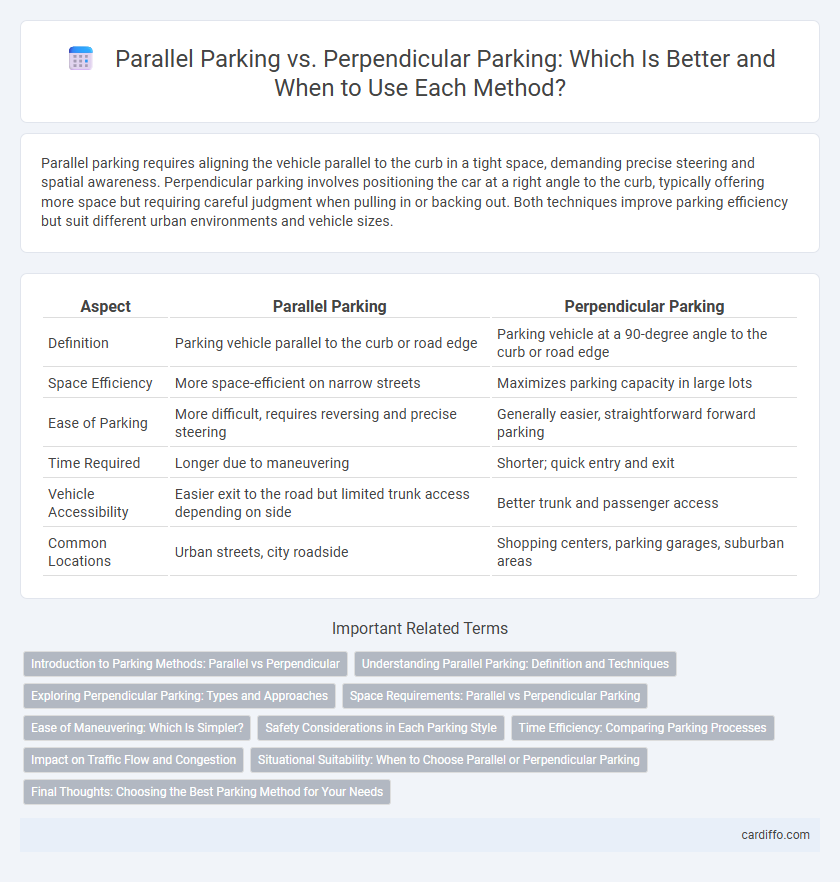Parallel parking requires aligning the vehicle parallel to the curb in a tight space, demanding precise steering and spatial awareness. Perpendicular parking involves positioning the car at a right angle to the curb, typically offering more space but requiring careful judgment when pulling in or backing out. Both techniques improve parking efficiency but suit different urban environments and vehicle sizes.
Table of Comparison
| Aspect | Parallel Parking | Perpendicular Parking |
|---|---|---|
| Definition | Parking vehicle parallel to the curb or road edge | Parking vehicle at a 90-degree angle to the curb or road edge |
| Space Efficiency | More space-efficient on narrow streets | Maximizes parking capacity in large lots |
| Ease of Parking | More difficult, requires reversing and precise steering | Generally easier, straightforward forward parking |
| Time Required | Longer due to maneuvering | Shorter; quick entry and exit |
| Vehicle Accessibility | Easier exit to the road but limited trunk access depending on side | Better trunk and passenger access |
| Common Locations | Urban streets, city roadside | Shopping centers, parking garages, suburban areas |
Introduction to Parking Methods: Parallel vs Perpendicular
Parallel parking involves aligning a vehicle parallel to the curb within a designated space, typically requiring precise maneuvering in tight urban environments. Perpendicular parking positions the vehicle at a 90-degree angle to the curb or aisle, maximizing space utilization in parking lots and garages. Understanding these methods is essential for efficient space management and driver safety in various traffic scenarios.
Understanding Parallel Parking: Definition and Techniques
Parallel parking involves positioning a vehicle parallel to the curb, typically in a tight space between two parked cars, requiring precise control and spatial awareness. Key techniques include aligning your car with the vehicle in front, reversing slowly while steering sharply toward the curb, and adjusting forward and backward to center the vehicle within the parking space. Mastering parallel parking enhances urban driving efficiency and safety in congested areas.
Exploring Perpendicular Parking: Types and Approaches
Perpendicular parking involves positioning vehicles at a 90-degree angle to the curb, maximizing space in parking lots and urban areas. Common approaches include head-in and back-in methods, each offering different visibility and safety advantages depending on the driver's preference and parking lot design. Types of perpendicular parking vary from single rows to multi-row configurations, optimizing capacity while facilitating smooth traffic flow.
Space Requirements: Parallel vs Perpendicular Parking
Parallel parking typically requires a longer curb space equivalent to the length of one vehicle plus extra clearance for maneuvering, often around 20 to 24 feet. Perpendicular parking demands a wider space per vehicle, usually about 8 to 9 feet wide and 18 to 20 feet deep, allowing cars to park side-by-side. Efficient parking lot design balances these dimensions to maximize capacity while accommodating vehicle turning radii and pedestrian pathways.
Ease of Maneuvering: Which Is Simpler?
Parallel parking generally requires more precise steering and spatial awareness, making it more challenging for many drivers to execute smoothly in tight urban spaces. Perpendicular parking offers a straightforward approach with ample room to align the vehicle, simplifying entry and exit in most parking lots. The ease of maneuvering thus often favors perpendicular parking, especially for less experienced drivers or when ample space is available.
Safety Considerations in Each Parking Style
Parallel parking typically offers enhanced visibility and easier pedestrian clearance, reducing the risk of collisions with passing vehicles. Perpendicular parking, while space-efficient, poses higher risks due to limited rear visibility and potential blind spots during entry and exit, increasing chances of minor accidents. Proper use of mirrors, cameras, and adherence to parking lane markings are crucial safety practices in both styles.
Time Efficiency: Comparing Parking Processes
Parallel parking generally requires more time due to precise maneuvering along the curb, often involving multiple adjustments to align the vehicle properly. Perpendicular parking typically allows quicker entry and exit since spaces are usually larger and vehicles enter straight in without complex steering. In busy urban settings, perpendicular parking maximizes time efficiency by reducing the duration spent positioning the car compared to parallel parking.
Impact on Traffic Flow and Congestion
Parallel parking typically occupies less curb space and allows for continuous traffic flow, reducing congestion on narrow streets. Perpendicular parking maximizes parking capacity in lots but requires vehicles to slow down or stop, potentially causing disruptions and backups. Urban planners often weigh these impacts to optimize traffic efficiency and minimize congestion in different environments.
Situational Suitability: When to Choose Parallel or Perpendicular Parking
Parallel parking is ideal for urban streets with limited curb space and heavy traffic flow, allowing vehicles to fit into tight spots along narrow roads. Perpendicular parking suits spacious parking lots and areas with low traffic congestion, enabling easier maneuvering and maximizing vehicle capacity. Choosing between the two depends on road width, traffic density, and available parking space to ensure safety and efficiency.
Final Thoughts: Choosing the Best Parking Method for Your Needs
Parallel parking offers a tight space-saving solution ideal for urban streets with limited curb space, while perpendicular parking maximizes capacity in parking lots by utilizing larger, designated spots. Consider factors like vehicle size, parking space availability, and maneuvering skill when selecting between the two methods. Evaluating these variables ensures efficient, safe parking tailored to your specific environment and needs.
Parallel parking vs perpendicular parking Infographic

 cardiffo.com
cardiffo.com